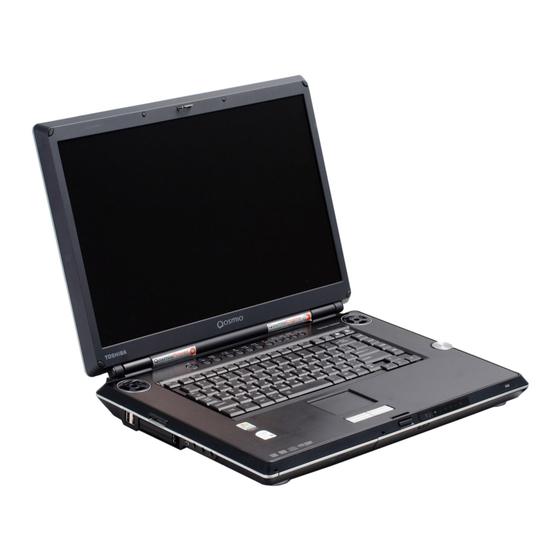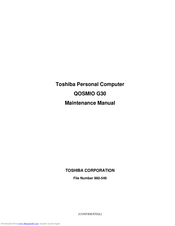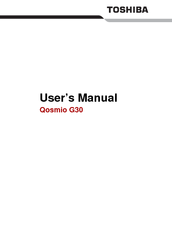
TOSHIBA Qosmio G30 Manuals
Manuals and User Guides for TOSHIBA Qosmio G30. We have 4 TOSHIBA Qosmio G30 manuals available for free PDF download: Maintenance Manual, User Manual
Toshiba Qosmio G30 Maintenance Manual (460 pages)
Table of Contents
-
-
Features15
-
Keyboard30
-
Power Supply33
-
Batteries36
-
AC Adapter39
-
-
-
-
Heatrun Test148
-
Subtest Names149
-
System Test151
-
Memory Test153
-
Keyboard Test154
-
Display Test155
-
Floppy Disk Test158
-
Printer Test160
-
Async Test162
-
Hard Disk Test163
-
Real Timer Test166
-
NDP Test168
-
Expansion Test169
-
Only One Test177
-
Operations177
-
Head Cleaning184
-
Operations184
-
Log Utilities185
-
Operations186
-
Running Test187
-
Operations187
-
-
Operations189
-
-
Operations194
-
-
LAN Test204
-
Modem Test207
-
Bluetooth Test208
-
Will Appear209
-
IEEE1394 Test218
-
-
Setup225
-
-
Figure245
-
Overview247
-
Battery Pack254
-
-
Bridge Media258
-
Hdd259
-
Memory Module263
-
Speaker Cover265
-
Keyboard266
-
MDC271
-
Bluetooth Module273
-
Cover Assembly274
-
Touch Pad278
-
Volume Board282
-
Switch Board285
-
RTC Battery293
-
JK Board294
-
LED Board296
-
System Board298
-
Speaker300
-
GPU Fan302
-
GPU Heat Sink309
-
Analog TV Tuner311
-
PC Card Slot312
-
LCD Cable319
-
Hinge325
-
Fluorescent Lamp327
-
-
-
Appendix
355-
-
-
-
Scan Codes415
-
-
-
US Keyboard423
-
UK Keyboard423
-
KO Keyboard424
-
TC Keyboard424
-
Advertisement
Toshiba Qosmio G30 User Manual (318 pages)
Portable Personal Computer
Table of Contents
-
Preface
27 -
Conventions
28 -
Heat Injury
31 -
Mobile Phone
32 -
Introduction
35 -
-
Features
37 -
Utilities
46 -
Options
50 -
Left Side
53 -
Right Side
55 -
Back Side
56 -
Underside
58 -
AC Adaptor
66 -
-
-
DLA for TOSHIBA101
-
Video101
-
Media Care
104-
CD/Dvds104
-
Floppy Disks104
-
-
TV Tuner
105 -
Sound System
107-
Volume Control107
-
Microphone Level107
-
-
Modem
109-
Region Selection109
-
Properties Menu110
-
Setting110
-
Modem Selection110
-
Connecting110
-
Disconnecting111
-
-
Lan
115 -
The Keyboard
119 -
Typewriter Keys
119 -
Hot Keys
121-
Fn Sticky Key124
-
-
Keypad Overlay
125 -
Power
127 -
Power Conditions
127 -
Power Indicators
128-
DC in Indicator129
-
Power Indicator129
-
Battery Types
129 -
-
User Password140
-
-
Power-Up Modes
142-
Hot Keys142
-
System Auto off
142 -
HW Setup
143 -
HW Setup Window
143-
Power on Display144
-
Boot Priority145
-
Device Config148
-
-
Other Settings
150 -
-
Windows Mode154
-
-
Watching the TV
166 -
Qosmioplayer
168 -
Optional Devices
189 -
PC Card
190 -
Expresscard
191 -
-
SD Card193
-
XD Picture Card197
-
Multimediacard198
-
-
Memory Expansion
200 -
Battery Packs
204 -
Battery Charger
204 -
External Monitor
208 -
Tv
209 -
Hdmi
211 -
S-Video-In
213 -
-
Precautions214
-
Connecting215
-
Disconnecting215
-
-
Security Lock
216 -
Troubleshooting
217 -
-
System Start-Up219
-
Self Test220
-
Power220
-
Ac Power221
-
Password222
-
Real Time Clock222
-
Keyboard223
-
Hard Disk Drive224
-
PC Card225
-
Expresscard226
-
SD Card226
-
Multimediacard227
-
XD Picture Card227
-
Pointing Device228
-
Touch Pad228
-
USB Device230
-
Memory Expansion230
-
Sound System230
-
External Monitor231
-
Modem231
-
Lan232
-
Wireless LAN232
-
Bluetooth233
-
TV Output Signal233
-
Video Playback234
-
Toshiba Qosmio G30 User Manual (302 pages)
Portable Personal Computer
Table of Contents
-
Preface15
-
-
Features25
-
Video Modes29
-
Utilities36
-
Options39
-
-
Work Habits66
-
Standby Mode73
-
-
Hd DVD95
-
Media Care96
-
TV Tuner97
-
Sound System99
-
Modem101
-
Region Selection101
-
Properties Menu102
-
Modem Selection102
-
-
Lan108
-
-
Typewriter Keys111
-
Hot Keys113
-
Fn Sticky Key116
-
Keypad Overlay117
-
Arrow Mode117
-
Numeric Mode118
-
-
Chapter 6 Power
121-
Power Conditions121
-
Power Indicators122
-
Battery Types123
-
DC in Indicator123
-
Battery Pack124
-
Power-Up Modes137
-
System Auto off138
-
-
-
HW Setup Window139
-
Power on Display140
-
Boot Priority141
-
Device Config145
-
-
Other Settings147
-
-
Watching TV163
-
Qosmioplayer166
-
Qosmioengine180
-
-
PC Card184
-
Expresscard185
-
Memory Expansion195
-
Battery Packs199
-
Battery Charger199
-
External Monitor204
-
Hdmi207
-
S-Video-In209
-
Security Lock212
-
-
-
Self Test216
-
System Start-Up216
-
Ac Power217
-
Real Time Clock219
-
Hard Disk Drive221
-
XD Picture Card226
-
Pointing Device228
-
Touch Pad228
-
Usb Mouse229
-
Usb Device230
-
Wireless Lan233
-
Video Playback235
-
TOSHIBA Support237
Advertisement
TOSHIBA Qosmio G30 User Manual (272 pages)
Portable Personal Computer
Table of Contents
-
Preface13
-
-
-
Work Habits57
-
Standby Mode63
-
-
Media Care80
-
Floppy Disks81
-
TV Tuner82
-
Sound System84
-
Modem86
-
Lan93
-
Chapter 6 Power
105-
Power Conditions105
-
Power Indicators106
-
Battery Types107
-
DC in Indicator107
-
Battery Pack108
-
Power-Up Modes120
-
System Auto off120
-
-
-
HW Setup Window121
-
Power on Display122
-
Boot Priority123
-
Device Config126
-
-
Other Settings127
-
-
Watching TV144
-
Qosmioplayer146
-
-
PC Card164
-
Expresscard165
-
-
Sd Card Care169
-
Write Protection170
-
XD Picture Card171
-
Memory Expansion174
-
Battery Packs178
-
Battery Charger178
-
External Monitor182
-
Hdmi185
-
S-Video-In187
-
Security Lock190
-
-
-
System Start-Up193
-
Self Test194
-
Ac Power195
-
Real Time Clock196
-
Hard Disk Drive198
-
Touch Pad202
-
Usb Mouse203
-
Usb Device203
-
Wireless Lan206
-
Tv Output Signal207
-
Video Playback208
-
TOSHIBA Support210
Advertisement



